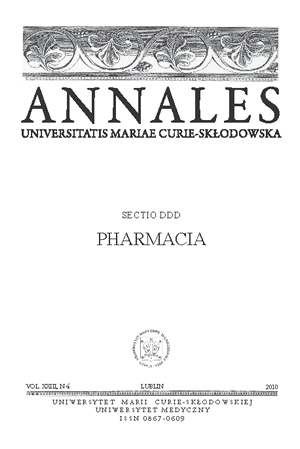Wpływ substancji uzyskiwanych z pestek winogron na system tlenku azotu w cukrzycy eksperymentalnej
Słowa kluczowe:
cukrzyca, arginina, cytrulina, arginaza, pestki winogronAbstrakt
Celem badań była ocena wpływu koncentratów polifenolowych „Merlo”, „Rkacitelli” na system syntazy NO u zwierząt kontrolnych i z cukrzycą doświadczalną typu 1 oraz typu 2.
Wykazano, że wzrostowi zawartości argininy w surowicy krwi, który stwierdzono w trakcie badań, towarzyszył spadek NO. Mogło to być efektem spadku powinowactwa enzymu do substratu jak też zmniejszenia transportu argininy do komórek w cukrzycy typu 1. Normalizacja poziomów NO, argininy i cytruliny w surowicy krwi szczurów po podaniu koncentratów polifenoli najprawdopodobniej zależy od ich wysokiej aktywności antyoksydacyjnej.
Bibliografia
1. Akamine E.H. et al.: Correction of endothelial dysfunction in diabetic female rats by tetrahydrobiopterin and chronic insulin. J. Vasc. Res., 43, 309, 2006.
2. Anfossi G. et al.: Contribution of insulin resistance to vascular dysfunction. Arch. Physiol. Biochem., 115, 199, 2009.
3. Caimi G.C.C. et al.: Diabetes mellitus: oxidative stress and wine. Curr. Med. Res. Opin., 19, 581, 2003.
4. Chein W.Y. et al.: Increased plasma concentration of nitric oxide in type 2 diabetes but not in nondiabetic individuals with insulin resistance. Diabetes Metab., 31, 63, 2005.
5. Chen M.J. et al.: Effect of proanthocyanidins on COX-2 enzyme activity and COX-2 mRNA protein expression in LPS-induced RAW264.7 cells. Yao Xue Xue Bao, 40, 406, 2005.
6. Davidson M.: A review of the current status of the management of mixed dyslipidemia associated with diabetes mellitus and metabolic syndrome. Am. J. Cardiol., 22, 19L, 2008.
7. Friederich M. et al.: Diabetes, oxidative stress, nitric oxide and mitochondria function. Curr. Diab. Rev., 5, 120, 2009.
8. Kasono K. et al.: Nicorandil improves diabetes and rat islets β-cell damage induced by streptozotocin in vivo and in vitro. Europ. J. Endocrinol., 151, 277, 2004.
9. Santangelo C. et al.: Polyphenols Intracellular signalling and inflammation. Ann. Ist. Super. Snita., 43, 394, 2007.
10. Sobrevia L. et al.: A role for insulin on L-arginine transport in fetal endothelial dysfunction in hyperglycemia. Curr. Vasc. Pharmacol., 7, 467, 2009.
11. Steinberg H.O. et al.: Insulin mediated nitric oxide production is impaired in insulin resistance. Diabetes, 46, 24, 1997.
12. Terra X. et al.: Inhibitory effects of grape seed procyanidins on foam cell formation in vitro. J. Agric. Food. Chem., 57, 2588, 2009.
13. Vanhoutte Р.М.: Endothelial dysfunction. The First Step toward coronary Arteriosclerosis. Circ. J., 73, 595, 2009.
14. Wei W. et al.: Oxidative stress, diabetes, and diabetic complications. Hemoglobin, 33, 370, 2009.
15. Yasuda H. et al.: NO-mediated cytotoxicity contributes to multiple low-dose streptozotocin-induced diabetes but not to NOD diabetes. Diabetes Res. Clin. Pract., 83, 200, 2009.
Pobrania
Opublikowane
Numer
Dział
Licencja
Prawa autorskie (c) 2010 Autorzy

Praca jest udostępniana na licencji Creative Commons Attribution-NonCommercial-NoDerivatives 3.0 Unported License.


